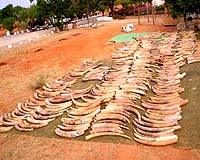| . |  |
. |
Cambridge, MA (SPX) Mar 24, 2010 A team of researchers at MIT and the University of California at San Diego has shown how cell division in a type of bacteria known as cyanobacteria is controlled by the same kind of circadian rhythms that govern human sleep patterns. Previous studies have shown that even though cyanobacteria do not "sleep" in the same way that humans do, they cycle through active and resting periods on a 24-hour schedule. Cyanobacteria depend on sunlight for photosynthesis, so they are most active during the day. The researchers demonstrate, for the first time, how the circadian clock regulates the bacteria's rate of cell division (their method of reproduction) in single cells. "These cells have to keep dividing, and the circadian oscillator regulates when they divide," says Bernardo Pando, an MIT graduate student in physics and one of the lead authors of a paper describing the findings in the March 18 online edition of Science. In multicellular animals, including humans, cell division is critical for renewal and repair, while out-of-control cell division leads to cancer, so "understanding how cells are dividing is really of fundamental importance," says Susan Golden, professor of molecular biology at the University of California at San Diego and an author of the paper. Cyanobacteria maintain their circadian rhythms even when isolated from the naturally occurring daily light-dark cycles of the sun, just as humans do. The researchers found that under conditions of moderate constant light, the cyanobacteria undergo cell division about once per day, and the divisions take place mostly at the midpoint of the 24-hour cycle To figure out how the cell division cycle is coupled to the circadian clock, the researchers sped up the cell cycle by boosting the intensity of light, enabling the cells to photosynthesize more, which increases the amount of energy available to them. The cells did start to divide more frequently, but in a pattern still linked to the circadian clock - they divided once a quarter of the way into the cycle, and again three-quarters into the cycle. The team also showed that the cyanobacteria enter a resting phase about 19 hours into the circadian cycle, after which they will not divide until the next cycle begins. How they did it: The researchers tracked single cells over a weeklong period. Proteins that govern the circadian clock were tagged with yellow fluorescent protein, so each cell's position in the 24-hour cycle could be pinpointed. Cells were also photographed every 40 minutes, so researchers could see when they divided. This is the first time researchers have studied how cell cycle and circadian rhythms are coupled in individual bacterial cells. "You can only do this by looking at single cells," says Alexander van Oudenaarden, MIT professor of biophysics and senior author of the paper. Next steps: The same experimental setup could be used to study the relationship between circadian clocks and any other cell function that oscillates periodically. Yeast and mammalian cells are logical targets for such studies, says van Oudenaarden. Golden is planning further studies into how the circadian clock and proteins that control cell division in cyanobacteria are linked. "Circadian Gating of the Cell Cycle Revealed in Single Cyanobacterial Cells," Qiong Yang, Bernando Pando, Guogang Dong, Susan Golden, Alexander van Oudenaarden. Science, March 19, 2010.
Share This Article With Planet Earth
Related Links Massachusetts Institute of Technology Darwin Today At TerraDaily.com
 UN wildlife body rejects bids to reopen ivory trade
UN wildlife body rejects bids to reopen ivory tradeDoha (AFP) March 22, 2010 A UN body rejected Monday proposals by Zambia and Tanzania to reopen trade in ivory that experts say would have worsened a surge in illegal trafficking driven by Asian-based organised crime. After a tense debate, the Convention on International Trade in Endangered Species (CITES), meeting in Doha, voted down Tanzania's request to sell 80.5 tonnes of stockpiled ivory to Japan and China. Z ... read more |
|
| The content herein, unless otherwise known to be public domain, are Copyright 1995-2010 - SpaceDaily. AFP and UPI Wire Stories are copyright Agence France-Presse and United Press International. ESA Portal Reports are copyright European Space Agency. All NASA sourced material is public domain. Additional copyrights may apply in whole or part to other bona fide parties. Advertising does not imply endorsement,agreement or approval of any opinions, statements or information provided by SpaceDaily on any Web page published or hosted by SpaceDaily. Privacy Statement |